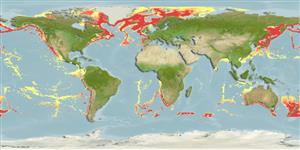Classification / Names
Common names from other countries
Main reference
Size / Weight / Age
Max length : 106 cm TL male/unsexed; (Ref. 6871)
Length at first maturity
Lm ?, range 94 - ? cm
Environment
Marine; bathydemersal; depth range 140 - 2500 m (Ref. 50610), usually 300 - 1500 m (Ref. 3167)
Climate / Range
Deep-water; -1°C - ? (Ref. 3167), preferred 5°C (Ref. 107945); 82°N - 50°S
Distribution
Northeast Atlantic: Spitsbergen to the Greenland-Iceland-Faroe-Shetland Ridge to northern Norway. Northwest Atlantic: Davis Strait between southwestern Greenland and Canada. Southeast Atlantic: southern tip of South Africa (Ref. 6871). Eastern Indian Ocean: off southern Australia (Ref. 6871). Southwest Pacific: New Zealand (Ref. 6871). Eastern Pacific: Costa Rica, Panama, Colombia, and Ecuador (Ref. 6871).
Countries | FAO areas | Ecosystems | Occurrences | Introductions
Short description
Grey-brown with large dark blotches (Ref. 26346). Tail very short (Ref. 26346). Mid-dorsal row of stout thorns which extend from nuchal region to first dorsal fin. Thorns close posterior to the pelvic girdle larger than along the tail (Ref. 6902). Upper surface dark mouse gray, dark blue gray or dark brown with small rounded spots. Lower surface white and sooty in variable patterns (Ref. 6902).
IUCN Red List Status (Ref. 115185)
Threat to humans
Harmless
Human uses
Fisheries: of no interest
More information
ReferencesAquacultureAquaculture profileStrainsGeneticsAllele frequenciesHeritabilityDiseasesProcessingMass conversion
Tools
Special reports
Download XML
Internet sources
Estimates of some properties based on models
Phylogenetic diversity index
PD50 = 0.5010 many relatives (e.g. carps) 0.5 - 2.0 few relatives (e.g. lungfishes)
Trophic Level
4.3 ±0.5 se; Based on diet studies.
Resilience
Low, minimum population doubling time 4.5 - 14 years (Fec assumed to be <100)
Vulnerability
High vulnerability (61 of 100)
Price category
